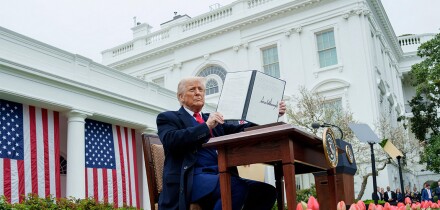Currency overlay is becoming increasingly popular with investors who need to manage foreign exchange risk. Essentially it is the outsourcing of foreign exchange risk management. Consider a U.S.-based investor who holds various overseas equity assets. At the start of each year, overseas equities are valued in U.S. dollars by converting the value in local currency using the exchange rate prevailing at the time. At the end of each year, the equities have a new local currency value. This is revalued into dollar terms using the year-end exchange rate. The profit or loss for the U.S.-based investor is thus the difference in these dollar valuations of the equities.
Thus we can see that the returns to the investor consist of two parts: the actual profit or loss on the foreign equity investment, and the profit or loss due to changes in the foreign exchange rate between the start and the end of the year. Currency overlay is designed to assist the kind of investors whose skill is in managing the former rather than the latter process. An investor may be very good at picking growth stocks overseas, but all of this will come to nothing if the profits are wiped out by an unexpected foreign exchange move.
Historically, the investor in this situation had three realistic choices--ignore the forex risk, hedge it with forward contracts, or hedge it with options. Ignoring it could lead to huge earnings volatility, while hedging it with forwards could eliminate most of the risk but also prevented the investor from profiting from favorable forex moves. Additionally, hedging with forex forwards has the effect of creating a cash requirement every time a losing hedge is rolled forward. Hedging with options allows the investor to profit from favorable moves while eliminating large forex losses, but option premiums can be expensive. Currency overlay aims to prevent large losses and participate in favorable moves, while remaining distinctly cheaper than option hedging.
How is this achieved? By means of proprietary forex models. The overlay provider uses the models, usually developed and tested over many years, to judge when it is appropriate to hedge and when the hedge should be lifted. The models should be able to spot trends and large moves and take action appropriately. A good currency overlay provider is thus of great benefit to an investor, like a U.S.-based corporate treasurer, who has overseas investments but does not wish to manage the forex risk alone.
The figures show that the forex effects upon overseas investments are not small. We have used the MSCI EAFE Index index to represent the overseas portfolio of the U.S.-based investor. Figure 1 is just the cumulative returns of the index over the last 10 years. Looking at this graph, we can see that overall the currency effects have averaged out to about zero. However, if we look at the currency effect year by year, in Figure 2, we can see that it is very large and very unpredictable, with its effects ranging from augmenting profits to completely wiping them out. Forward hedging would have eliminated the forex effect. Option hedging would have allowed the investor to capture the favorable moves, while protected from the adverse moves, but only at a cost. Currency overlay aims to capture the profitable forex effect in Figure 2, while hedging the loss-making periods, without charging the high-premium costs associated with options. While this sounds attractive, it should be realized that only the best overlay managers consistently achieve this goal.
It can be seen, looking at Figures 1 and 2, that simply holding an unhedged overseas equity position exposes the investor to significant currency risk. By not hedging, the investor will be inadvertently speculating in the currency. Prudent investors will consider all the hedging strategies available to them.
An important part of selecting an overlay strategy is choosing the benchmark. This is a portfolio relative to which the strategy will be judged. Thus in the example above, the EAFE index could be taken as the benchmark. The overlay manager would be expected to outperform the benchmark, either by achieving the same return with lower volatility, or by achieving a higher return without significantly increasing volatility. In other cases, a partially or totally hedged portfolio could be selected as the benchmark. The overlay manager would then judge when the degree of hedging could be varied from the benchmark level.
Currency overlay historically has been popular in the U.S., where treasurers and portfolio managers traditionally have more experience and expertise in the equity arena than in currency management. However, it is now becoming more popular in Europe, as investors wake up to the fact that it is possible to outsource forex risk management to institutions with strong forex backgrounds.
This week's Learning Curve was written by Jessica James, head of research for strategic risk management advisory at First National Bank of Chicagoin London.






